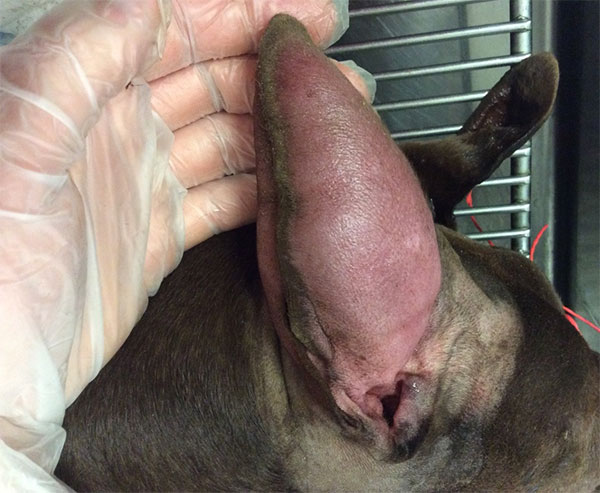New RVC research reveals dog breeds with folded ears more likely to suffer from blood blisters of the ear
Aural haematoma, also known as a ‘blood blister of the ear’, is a distressing condition for dogs where the ear flaps fill with bloody fluid.

New research from the Royal Veterinary College (RVC) has found that dog breeds with folded ears (v-shaped drop and semi erect ear carriage) have higher risk of developing this condition compared to breeds with erect ear carriages.
In particular, the research revealed 14 dog breeds that are particularly prone to aural haematoma. The worst affected breeds included Bull Terrier, Saint Bernard, French Bulldog, Irish Staffordshire Bull Terrier and English Bull Terrier. With the condition being highly distressing and likely painful for dogs, this information is key in helping owners recognise the problem and seek appropriate veterinary care faster.
The paper, ‘Reporting the epidemiology of aural haematoma in dogs and proposing a novel aetiopathogenetic pathway’ that is published in Nature Scientific Reports reveals the true scale of aural haematoma, with one in every 400 dogs in the UK suffering from the condition each year.
Aural haematoma describes a build-up of bloody liquid that forms within the ear flap of a dog. It was previously thought that this resulted from blood vessels that burst when dogs shake their head or scratch their ear too hard.
But the findings of this latest RVC study challenge this idea. The team of RVC researchers have proposed a new theory to explain the causation of aural haematoma. Rather than resulting from headshaking, a cartilage-folding hypothesis is proposed whereby repeated folding of the ear flap along the line of cartilage fold within certain types of ear carriages leads to chronic damage and weakness along this fold line. This damage eventually triggers a bleeding episode into the ear flap.
The study, led by the RVC’s VetCompass Programme, is the largest ever study to use anonymised veterinary health records to explore aural haematoma in dogs. After following the clinical records of 905,554 dogs for a one-year period, the researchers identified that 0.25% (2,249 dogs) were affected by the disease.
Key findings from the study include:
- Fourteen breeds showed an increased risk of ear aural haematoma compared with crossbred dogs.
- The breeds with the highest risk included Bull Terrier (x 7.4 the risk of crossbred dogs), Saint Bernard (x 7.3), French Bulldog (x 7.0), Irish Staffordshire Bull Terrier (x 5.5) and English Bull Terrier (x 5.4).
- Twenty breeds showed a reduced risk of ear aural haematoma compared with crossbred dogs. The breeds with the lowest risk included Greyhound (x 0.1 times the odds of crossbred dogs), Chihuahua (x 0.1), Miniature Dachshund (x 0.1) and Pomeranian (x 0.1).
- Compared with breeds with erect ear carriage, breeds with V-shaped drop ear carriage had 2.0 times the risk of ear aural haematoma and breeds with semi-erect ear carriage had 1.6 times the risk. Conversely, breeds with pendulous ear carriage had reduced (x 0.6) risk.
- Increasing body weight was associated with an increased risk of ear aural haematoma, with dogs ≥ 40kg at 8.5 times the risk compared with dogs < 10kg.
- Dogs aged 10 to 12.0 years were at the greatest risk of ear aural haematoma (x 5.6) compared with dogs under 1.0 year.
This new research from the RVC aims to improve awareness of both the frequency of aural haematoma in dogs and generate new insights into which breeds, and ear types are most susceptible.
Dr Dan O’Neill, Senior Lecturer in Companion Animal Epidemiology at the RVC and lead author of the paper, said:
“Humanity evolves when it sees the world in new ways. This study is evidence of the power of veterinary Big Data to generate a new theory explaining why dogs develop aural haematoma, a disorder that has been recognised in dogs for a century.”
Dr Zoë Halfacree, co-author and Soft Tissue Surgeon at Davies Veterinary Specialist, said:
“The use of the VetCompass data in this epidemiological study has provided an invaluable insight into dog breeds predisposed to this painful condition.”
Dr Yan Hui Lee, co-author and RVC’s BVetMed Class of 2021 Graduate, said:
“Now that I am working as a general practitioner, issues related to the ear are one of the most common presenting complaints that I see daily. This study enabled me to understand aural haematoma better and I now use this information to offer improved advice to my clients.”
Bill Lambert, Health, Welfare and Breeder Services Executive at The Kennel Club, said:
“These extensive findings importantly help us to identify which dogs are most at risk of developing aural haematoma, which can be a painful disorder amongst some dogs.
“Ultimately this research, funded in part by The Kennel Club’s Charitable Trust as part of our mission to make a difference for dogs, should help owners that may need support in spotting the initial signs and seeking appropriate veterinary care, particularly in those breeds identified as being at most risk of being affected.
“The data from this research will also be used to collaboratively create strategies to tackle health priorities with the breed clubs of affected breeds.”
This study was supported by an award from the Kennel Club Charitable Trust and Agria Pet Insurance.
Notes to Editors
The full paper is available from 9 November and can be accessed here: https://www.nature.com/articles/s41598-021-00352-0
Reference
O’Neill et al. (2021) “Reporting the epidemiology of aural haematoma in dogs and proposing a novel aetiopathogenetic pathway”, Scientific Reports
For media enquiries, please contact:
- Jasmin De Vivo (jasmin.devivo@plmr.co.uk) or rvc@plmr.co.uk
- Press Line: 0800 368 9520
About the RVC
- The Royal Veterinary College (RVC) is the UK's largest and longest established independent veterinary school and is a Member Institution of the University of London. It was the first in the world to hold full accreditation from AVMA, EAEVE, RCVS and AVBC.
- The RVC is ranked as the top veterinary school in the world in line with the QS World University Rankings by subject, 2021.
- The RVC offers undergraduate and postgraduate programmes in veterinary medicine, veterinary nursing and biological sciences.
- In 2017, the RVC received a Gold award from the Teaching Excellence Framework (TEF) – the highest rating a university can receive.
- A research led institution with 79% of its research rated as internationally excellent or world class in the Research Excellence Framework 2014.
- The RVC provides animal owners and the veterinary profession with access to expert veterinary care and advice through its teaching hospitals and first opinion practices in London and Hertfordshire.


